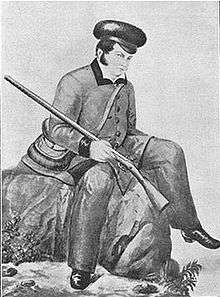Agustín V. Zamorano
| Agustín Vicente Zamorano | |
|---|---|
 | |
|
In office 1832–1833 | |
| Preceded by | Pío Pico |
| Succeeded by | José Figueroa |
| Personal details | |
| Born |
1798 Spanish Florida |
| Died |
1842 San Diego, Alta California |
| Spouse(s) | María Luisa Argüello |
| Profession | Civil Servant, politician, printer, soldier |
| Religion | Catholic |
| Military service | |
| Rank |
|
| Commands | Presidio of San Diego |
Agustín Vicente Zamorano (1798 – 1842), was a printer, soldier, and provisional Mexican Governor of Alta California.
History
Agustín Zamorano was born in Spanish Florida to Spanish parents within the Spanish colonial Viceroyalty of New Spain. He entered the newly independent Mexican army May 1, 1821 as a cadet, where he served in Mexico.
Alta California
He then came north in 1825 to the Mexican territory of Alta California, as Secretary of State to Governor José María Echeandía. He served until 1831, during which he would create and print official letterhead, using woodblocks and type, without a printing press.
In February 1827 Zamorano married María Luisa Argüello, daughter of Santiago Argüello, in a noted double wedding in San Diego. His children were Dolores, Luis, Gonzalo, Guadalupe, Josefa, Agustín, and Eulalia. Zamorano participated in the 1831 Mexican Revolution, heading a group of rebels in Monterey, including a number of foreign residents, as Captain of the Monterey Company.
Governor
When Governor Manuel Victoria was exiled from California in January 1832, in the face of revolution from stopping the Mexican government's secularization the Alta California missions and redistribution of the land holdings as land grant ranchos Echeandía remained acting governor until an assembly met in Pueblo de Los Angeles. Pío Pico was chosen governor according to the Plan of San Diego, but officials in Los Angeles refused to recognize him.
Zamorano proceeded to lead a rebellion in northern Alta California, and acting as governor there, with Encheadía acting as governor in southern Alta California. During January 31, 1832 – January 15, 1833, Zamorano served as provisional Governor of Alta California at Monterey in the north, with José María de Echeandía serving at Pueblo de Los Angeles in the south.
When Governor José Figueroa arrived in 1833, Zamorano returned to his former duties as his secretary.
Printer
Zamorano is most noted for being the first person to bring a printing press to California, a wood-frame Ramage press purchased in Boston. He set up a print shop in Monterey in the summer of 1834 and published the first books in California. As secretary to the Mexican Governor, he printed early proclamations of Mexican governors.
The first items issued were a sixteen-page Reglamento (1834) and about a half-dozen broadsides and sheets.
The first book printed was Manifiesto a la Republica Mejicana in 1835. The Manifesto granted amnesty to the people of Alta California after the recent rebellion.
He also offered to provide "equitable prices with gentlemen who may wish to establish any periodical," but nobody took up his offer. In total, he printed eleven broadsides, six books, six miscellaneous works, and numerous letterheads.
The first newspaper wasn't printed until U.S. Commodore Robert F. Stockton found Zamorano's old press and Walter Colton, chaplain of the U.S. frigate Congress and former editor of the Philadelphia North American started the Monterey Californian.
Later years
Capt. Zamorano was the last appointed Commandant of the Presidio of San Diego during 1835-1840, but never assumed command. He was in San Diego in that period only during 1837-1838.
Agustín Zamorano left Alta California in 1838, later returning to San Diego in 1842, and died that year.
Legacy
The Zamorano Club was formed in 1928 by a group of California book collectors, printers and librarians in honor of Agustín Zamorano.
In 1986, Zamorano Fine Arts Academy, an Elementary School in Southeastern San Diego was named in his honor.
In 2012, Agustin Vicente Zamorano descendant, Celeste Montalvo created a Facebook page at https://www.facebook.com/AgustinVicenteZamarano for descendants to post family pictures and share their history.
See also
References
- Smythe, William E. (1907–1909). "part II, chapter VI". History of San Diego, 1542-1908. Los Angeles: Reprinted 2003 by Arthur H. Clark Co. Retrieved 2006-12-31.
- Harding, George L. (1934). Don Agustín V. Zamorano: Statesman, Soldier, Craftsman, and California's 1st Printer. Los Angeles: Reprinted 2003 by Arthur H. Clark Co. ISBN 978-0-87062-325-7.
